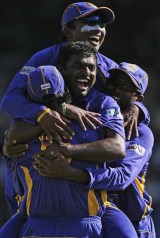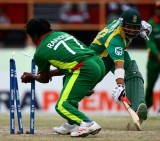
|

The game has given them much, and the players from Sri Lanka and Bangladesh know that and are ready to give something back
© AFP
|
|
The joy of cricket, the vitality of it, in the subcontinent has migrated southwards and eastwards. Whether it is a permanent shift or just temporary asylum can only be guessed but, as Karachi and Mumbai stand jaded, Colombo and Dhaka are set to sparkle.
How has this become the case? After all, the four teams share many traits. All have - or had until recently - foreign coaches; two have succeeded, two have failed and no new light is shed on an old debate.
And it isn't as if Sri Lanka Cricket and the Bangladesh Cricket Board are models of corporate and administrative virtue. No cricket board is perfect and those in the subcontinent, in particular, are less perfect than others.
Is it to do with the personnel for, as we are tiresomely reminded, talent fairly gushes out of every subcontinent galli and village? Perhaps age, and the blend of old with new, has a little to do with it, but it's not entirely that. Pakistan and Bangladesh had 12 players under 30 in their squads and three over, India 11 under and four over. Sri Lanka have a whopping six over 30. For experience in terms of matches, Sri Lanka are sandwiched between India and Pakistan, all well ahead of Bangladesh.
Instead, there is a feel about both teams, a sense captured equally through TV sets thousands of miles away and in stadiums where they've played.
Suresh Menon and
Rahul Bhattacharya have articulated in greater detail this vibrancy but how enamoured their players are with the game and only the game is clear. They are devoted to it, not in a dutiful sort of way but more beholden by it: the game has given them much, they know, and they have to give back to it, they also know.
In odd ways it reveals itself. In the dance of the elderly, for example: the oldest players in a line-up can often be the weakest links but, when needed, they can also be the strongest. Muttiah Muralitharan, Sanath Jayasuriya and Mohammad Rafique have not only scored and stopped runs and taken wickets when necessary, they have done it with the zest of men half their age and in their first internationals. The contrast with the sullenness emanating from Sachin Tendulkar, Rahul Dravid, Inzamam-ul-Haq and Mohammad Yousuf is stark.
 Bangladesh and Sri Lanka have not only fielded better, they have enjoyed doing so much more. Jonty Rhodes says that fielding should be fun and watching these two, you see the wisdom of simple words
Bangladesh and Sri Lanka have not only fielded better, they have enjoyed doing so much more. Jonty Rhodes says that fielding should be fun and watching these two, you see the wisdom of simple words

|
Most vividly it can be seen in the field. Efforts in batting and bowling are often slave to situation and circumstance; pitch and weather conditions, chasing a big total, defending a small one, the form of key players. Fielding largely operates outside these confines and so is often a more accurate indicator of a side's mood and health.
Bangladesh and Sri Lanka have not only fielded better, they have enjoyed doing so much more. Jonty Rhodes says that fielding should be fun and, watching these two, you see the wisdom of simple words. Conversely, Pakistan and India give the impression that fielding is as much fun as the ICC.
It's strange, in fact, how India and Pakistan resemble each other so. On the field, there has been a spooky sameness; results and performances in South Africa were nearly identical, the Champions Trophy and World Cup, both failures. Both batting line-ups struggle in alien conditions, as fielders both are poor and both leaders increasingly embattled and embittered. Both now rebuild.
Off it, they are cricket's Paris Hilton and Britney Spears. One, pure monied trash, influential for no other reason than having too much of it, the other straight-up trailer trash, cricket's true basket case. They are tabloid fodder, stumbling from one front page to another: religion, player factionalism, spats, coaching intrigues, politicking, doping and even possible murder. How much of the news that you have read about these two sides recently has been about their cricket?

|

Bangladesh seniors like Mohammad Rafique play as if in their first international, with much enthusiasm
© AFP
|
|
In this world, how much could they have really enjoyed playing cricket when they know that failure, among other things, means hysterical reactions from fans and contract suspensions? Their love of the game shouldn't be questioned but they walk the field burdened, their cricket joyless. Bangladesh and Sri Lanka either have no burdens or they have managed to put them aside. They are floating in a rare time, in the midst of substantial development and progress and it shows.
It is inaccurate and hasty to talk of new standard-bearers. Sri Lanka were world champions ten years ago and have long been a top side. This is only Bangladesh's first creditable performance in a multi-nation event. Those are lofty questions not answered on the basis of even the biggest tournament of all. But clearly, on the subcontinent, these are the best of times and the worst of times
Osman Samiuddin is Pakistan editor of Cricinfo



